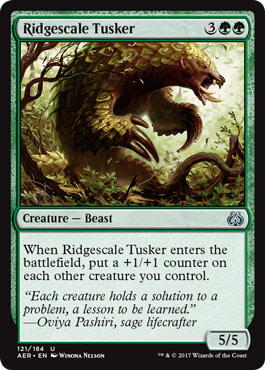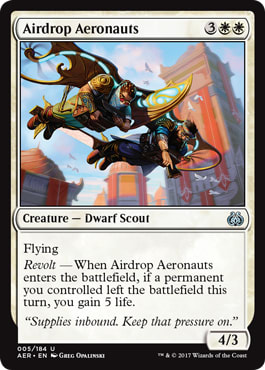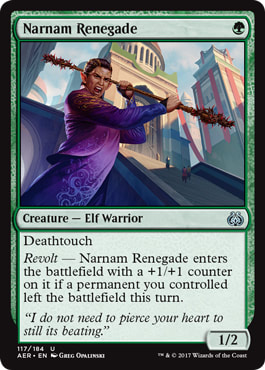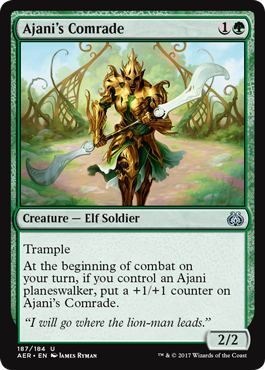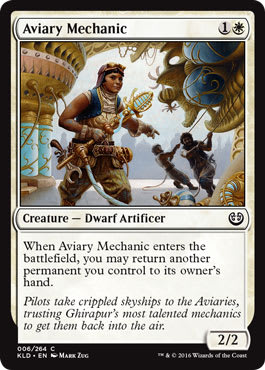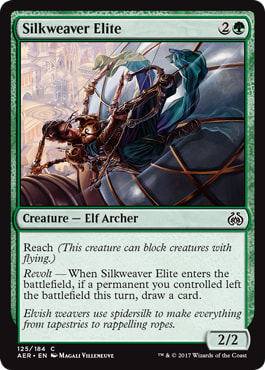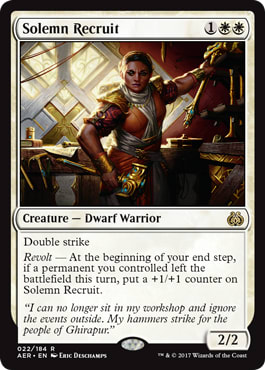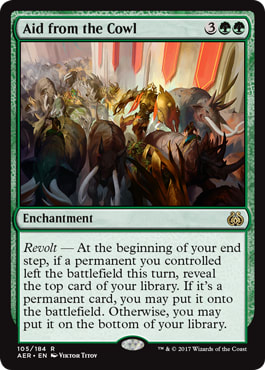You may recall last week I took a first look at the two Planeswalker Decks for Aether Revolt. This being only the second release in the product line, it’s an interesting indicator of how they want the Decks to be positioned. With Kaladesh, they appeared to focus heavily on the set’s mechanics, consigning the “Planeswalker identity” bit to a lesser subtheme. This was welcome — one of the things I enjoy most about Preconstructed Magic is how decks can represent the themes of a set, and mechanical identity goes a long way toward doing that.
With Kaladesh, we were given a Vehicles-themed deck, and one built around Energy. This time around, revolt and improvise were given the limelight. Today we’ll be taking a closer look at the Ajani-themed deck, and putting it through a Meddling.
A Meddling is the deck-building series where we take a Preconstructed deck, break it down to its core components, and then look to rebuild it to better reinforce its themes. In order to keep the finished product both affordable and readily accessible, there are two “golden rules” that guide the deck’s reconstruction.
First, the only cards in the card pool are those currently found within the deck. In this case, that means Kaladesh and Aether Revolt.
Second, no adding rares or mythics. We can use what we have already in the deck, but we can only add in commons and uncommons.
Now, let’s take another look at Ajani’s deck, to see what we’re building toward and what we have to work with.
Ajani?s Planeswalker Deck ? Planeswalker Deck | Wizards of the Coast
- Creatures (21)
- 1 Airdrop Aeronauts
- 1 Deadeye Harpooner
- 1 Ghirapur Guide
- 1 Ridgescale Tusker
- 1 Solemn Recruit
- 2 Armorcraft Judge
- 2 Lifecraft Cavalry
- 2 Narnam Renegade
- 2 Silkweaver Elite
- 2 Verdant Automaton
- 3 Ajani's Comrade
- 3 Audacious Infiltrator
- Planeswalkers (1)
- 1 Ajani, Valiant Protector
- Instants (1)
- 1 Natural Obsolescence
- Sorceries (6)
- 1 Engineered Might
- 1 Prey Upon
- 4 Inspiring Roar
- Enchantments (5)
- 1 Aid from the Cowl
- 2 Ajani's Aid
- 2 Unbridled Growth
- Artifacts (4)
- 1 Daredevil Dragster
- 3 Renegade Map
- Lands (22)
- 9 Forest
- 9 Plains
- 4 Tranquil Expanse
Ajani’s deck is largely comprised of three separate and distinct themes, without a great deal of overlap or synergy. First and foremost, there’s the revolt theme. Spells with revolt reward you for having a permanent leave the battlefield prior to casting, giving you an added effect if you’ve satisfied that condition. As noted last week, the deck is surprisingly lacking in ways to let you take control of your own destiny by triggering revolt, despite several cards in-set that would allow you to.
The second theme is “+1/+1 counters matter.” This was a bit of a weak theme, mainly because only one card (Armorcraft Judge) actually cares about +1/+1 counters, but a number of other cards make use of them. If nothing else, it’s a fine way to grow some creatures and add pressure in the red zone.
Finally, there’s the Planeswalker theme. This consists of just three different cards: Ajani's Aid, Ajani's Comrade, and Ajani, Valiant Protector. The Planeswalker component of the decks thus far has been essentially like a bubble in water, something that sits atop of rather than within the construction. Of course, the Planeswalker card is a big part of the charm of these decks, and we’re going to want to keep what we can from this admittedly minor subtheme.
So with the basic outline of the deck laid out, it’s time to take our scalpel and start making room for the improvements.
Cutting
The first card getting a pink slip is the Verdant Automaton. A two-mana 1/2 is inefficient, and while it does tie into the “+1/+1 counters” theme, that’s the weakest of the deck’s three themes. If you pump this even once and your opponent responds with removal, you’ve just been put out 6 mana. Not worth it.
Audacious Infiltrator is the most recent in a storied line of White 3/1’s. It’s perfectly priced at 2 mana, and even comes with a rider preventing your opponent from blocking with artifact creatures. Somehow, this card just resonates “Antiquities” to me, but that’s not enough to keep it on the roster. You want to jam 3/1’s in an aggressive deck that can make the most of relentless attacking, and this deck isn’t that. Much of the time you’ll be facing non-artifact creatures, rendering the Infiltrator’s special ability moot. It’s a decent card, but just not one that has a place in what we’re building.
Ghirapur Guide is another cut. Like the Automaton, these are stall-buster cards. The idea is, if the game goes long and the red zone is too congested, and you and your opponent can’t seem to profitably attack, you can move the game toward its conclusion through the use of all that mana you’ve built up. For the Automaton, that means adding more and more counters, and for the Guide that means making creatures unblockable. This is a common in Preconstructed decks, which — thanks to their less-tuned nature — can often stall out in the late-game.
Then there’s the Lifecraft Cavalry, another beneficiary of the conditional hoop of revolt. Fail to get that off, and you get an expensive 4/4, even with trample. Manage to satisfy the keyword, and you’ll get a 6/6 instead. The problem here is that there really are only two ways to lose a permanent off the battlefield: voluntary and involuntary. Involuntary relies by necessity on your opponent. Voluntary means you have to make it happen, which typically will cost mana. Adding that cost on top of the 5 mana this card costs, which makes this card a poor choice in both ways. You either have to hope your opponent cooperates, or have loads of mana on the table. Neither are reliable.
The Ridgescale Tusker is a nice effect on an efficient creature, and it really doesn’t do anything wrong. The problem is, the +1/+1 counters strategy isn’t really one we’re going to be pursuing in this deck, because it’s a lot of work for a very modest payoff. If there were more cards like Armorcraft Judge, it might be worth considering, but we’re just going to be building too tightly to find this one a home.
Finally, we’ll also be dispensing with the services of the Airdrop Aeronauts. An evasive 4/3 isn’t bad, and if it wasn’t for Ajani, Valiant Protector’s synergy with the Armorcraft Judge, we’d run this over that quite happily. The lifegain is incidental, but 4 power in the air would be a nice closer. Alas, we have only so many slots, and our finished deck is going to want to be a bit more aggressive in the early-to-midgame transition.
The Rebulid
So now that we’ve cut the dead weight, how to replace it?
First, we’ll be going up to four copies of Narnam Renegade. A 1/2 with deathtouch is already a nice deal for 1 mana, and the prospect of a 2/3 is hard to resist, as long as we’re able to trigger revolt reliably. Funnily enough, a Renegade can be the revolt trigger for another Renegade, if you’re able to keep up positive pressure on your opponent’s defense and they opt for a trade. We’ll go for a full playset, to maximize our chances of drawing into these early.
Next up is Ajani's Comrade. This isn’t a bad card, being Grizzly Bears with trample and a conditional upside. Because we won’t always have Ajani in play, however, we’re going to drop the quantity down to two copies. When we don’t have Ajani in play, it’s passable, but it synergizes with both Ajani and the Armorcraft Judge, being a rare card that can tie the disparate themes together.
Next we’ll be adding in four copies of the Aviary Mechanic. This isn’t included in the stock deck, but is just the sort of revolt enabler the deck needs to be more reliable. It’s not a great card — at least with Kor Skyfisher you got some added punch because of the forced return, as opposed to the optional one the Mechanic offers, but we’re working with what we have. Because so many of our creatures will fall into the cheaper end of the spectrum, returning a tapped land to hand to replay is a fine tradeoff for maximizing the deck’s potential through revolt.
We’ll be retaining the services of the pair of Silkweaver Elite, which aren’t a great card in a vacuum but acceptable with the offer of card advantage. We’ll also be going for a full playset of the Deadeye Harpooner. This is the card that can really make the deck come together, especially with the Aviary Mechanic. Cast the Harpooner, then next turn return it to hand with the Mechanic and resummon. This will help thin out the opponent’s defenses, and let your swarm start chunking off your opponent’s life total.
Another card we’ll be pulling in from the outside is the Aerial Responder. We’ll want a playset of these, which are essentially a reverse Vampire Nighthawk. Flying, vigilance, and lifelink, this thing does a lot of the heavy lifting in the deck, and can help you outrace your opponent by swinging the game by 4 life each time it connects. It’s a very solid card, and an easy inclusion.
Finally, we’ll be keeping the Solemn Recruit and pair of Armorcraft Judges. The Recruit is a splashy rare, and can make games very swingy if you manage to pull of revolt a couple of times. With 23 creatures, most of them aggressively costed, you should have little problem growing her prowess through a combination of orchestration and combat attrition. The Judges get the nod because of their synergy with Ajani and Ajani's Comrade, as well as cards like the Narnam Renegade and Solemn Recruit. Even if you only get one card off of it, it’s a decent deal.
Spells
With 23 creatures in the deck, that leaves room for only 13 spells to support the deck. We’ll go ahead and keep Aid from the Cowl, to start off with. It’s a card I’d personally cut, but it’s flashy and fun which is what a rare should be at this level.
Next we’ll keep the pair of Ajani's Aids. I don’t love this spell — it’s a fine cost when you need to tutor up your Planeswalker, but it’s a dreadful card when you’ve already played him. Still, because we want to be able to find Ajani more often (the design of these decks), it gets the nod.
We’ll also take a pair of Daredevil Dragsters. The Dragster has crew 2, so it’s a great use of cards like the Aviary Mechanic, and another card draw outlet is always nice.
That leaves eight cards for combat tricks and removal. For the tricks, we’ll go with a set of Alley Evasion. This is a great bimodal spell where both modes have a lot of use in this deck. We want combat tricks to keep the opponent off-balance, and being able to bounce cards back to hand not only can save them from removal, but also can trigger revolt.
We’ll also add a trio of Skywhaler's Shots. Anything with a power of 2 or less should be something the deck can manage in the red zone. This way, we can pick off the threats our opponents play that can stop our attack. This deck wants to push forward like an aggro deck, while still having some synergies and tricks to make it more than the sum of its parts.
Here's the deck’s final list.
Meddled Ajani ? Planeswalker Deck | Jay Kirkman
- Creatures (23)
- 1 Solemn Recruit
- 2 Ajani's Comrade
- 2 Armorcraft Judge
- 2 Silkweaver Elite
- 4 Aerial Responder
- 4 Aviary Mechanic
- 4 Deadeye Harpooner
- 4 Narnam Renegade
- Planeswalkers (1)
- 1 Ajani, Valiant Protector
- Instants (7)
- 3 Skywhaler's Shot
- 4 Alley Evasion
- Enchantments (3)
- 1 Aid from the Cowl
- 2 Ajani's Aid
- Artifacts (2)
- 2 Daredevil Dragster
Thanks for reading! I’ll be back next week with a look at Tezzeret’s deck. See you then!





















